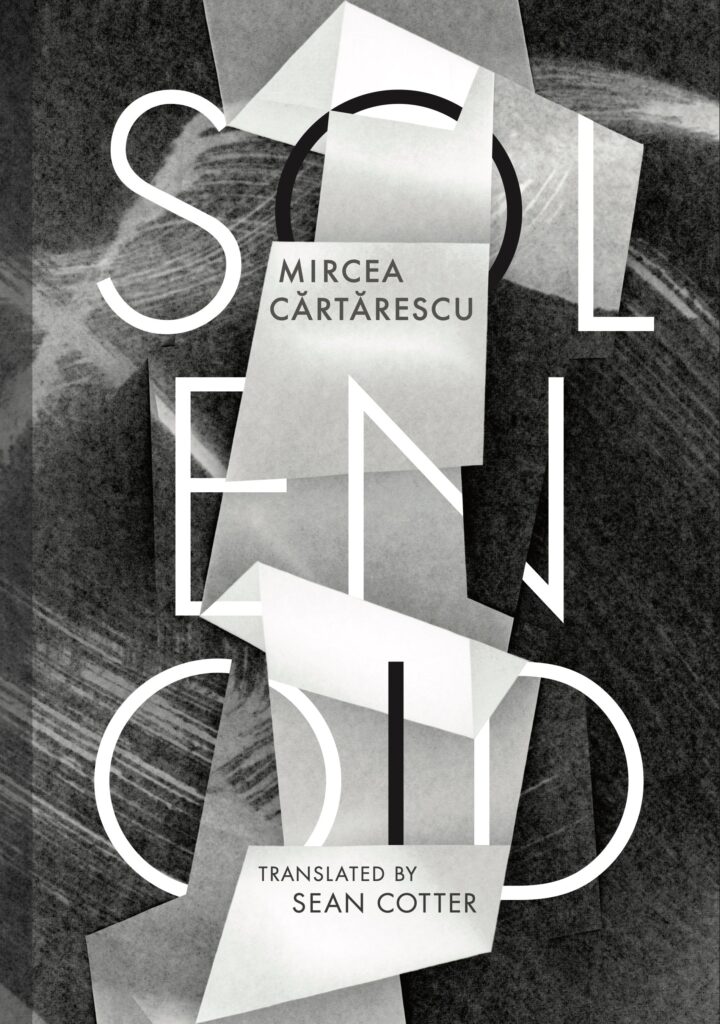
[Deep Vellum; 2022]
Tr. from the Romanian by Sean Cotter
The Penrose Stairs are a famous optical illusion dating back to the 1950s, depicting a square flight of steps that seem to ascend forever around a series of ninety degree turns. They are paradoxical, contradictory. They are something that the mind can understand, while also recognizing the baseline unreality of the thing. They are an impossibility—at least within the confines of our world.
Finally available in English, Mircea Cărtărescu’s Solenoid is a book that might be impossible to discuss without a veritable library of comparisons, because as most reviews of this book have noted, it’s exceedingly difficult to quickly sum up exactly what Cărtărescu has achieved. And Solenoid really is an achievement.
Like the Penrose Stairs, or other “impossible objects,” it is a challenge to even find an entry point to discuss Solenoid, because, like an optical illusion, it does not abide by the rules of our reality. Of course, an optical illusion is best seen for oneself, and similarly, to do justice to a book like Solenoid would require a review as long as the novel in question. Trying to describe it is difficult, because Solenoid is so dizzying in its execution that it is best understood from within, and anything less than the entire book requires willfully ignoring some of its fractalized genius. Across its 700 pages, it records a woozy topography of life, death, and literature, cataloging a world that it both intends to depict, and depart. Solenoid is the real thing—an honest-to-god novel of ideas, concerned with old fashioned, big picture philosophizing. This swirling existentialism, and Cărtărescu’s baroquely maximalist approach, make Solenoid feel as if it were a book from the nineteenth or twentieth century that has somehow been leaking into the modern world. It is a masterpiece in a league of its own.
It begins with a joke.
Our narrator is somewhat of an archetypal one, familiar to readers of books by, and about, European Men (capital letters). Solenoid offers another entry to the canon of failed writers who are preoccupied with some of the grotesqueries of having to occupy a physical form. From the start, the book is tremendously and joyously strange, opening with an assault on the senses and sensibilities that’s as obsessive as Thomas Bernhard, and as scatological as James Joyce. We are given a half-dozen paragraphs about lice, their eggs and excrement, and the main character’s body, which ultimately give way to a quiet moment in which our narrator sits alone, quite literally gazing at his navel. From there, the world only gets wider, and weirder.
Structurally, Solenoid is presented as a group of notebooks written by the nameless narrator (presumably Cărtărescu himself, at least at first). These diaries—referred to always as a “text,” because “book” implies readers—comprise a loosely woven chain of themes and plot points that could be read as a distant, more playful cousin to the Book of Disquiet, or an updated Tristam Shandy. It’s almost episodic at points, digressing to follow other teachers at the school where our main character works, or to talk about the decay (both literal and metaphorical) threatening the heart of the city of Bucharest, or to introduce a growing protest movement against the very concept of death.
Once it reaches top speed, the book is written almost as a stream of un-consciousness, mounting a full-scale attack on the boundaries between fact and fiction, dreams and reality, this dimension and countless others. It imagines a world where Cărtărescu is a failure, instead of one of his country’s most celebrated living writers. It offers glimpses of strange, otherworldly beasts and levitating statues. The main character lives in a house that resembles a child’s drawing of a boat, with a tower in its center that contains nothing but perfect darkness and a dentist’s chair. We plunge, headfirst, through many five-dimensional dream sequences before landing back in bed.
Needless to say, Solenoid is often overwhelming in its scope and ambition, but it handily succeeds because no particular moment overstays its welcome or becomes otherwise unsatisfying. As soon as the reader gets their bearings, Cărtărescu pulls a rug out from above your head, revealing the floor to have been the ceiling all along. Miraculously, it’s a trick that never gets old.
Between the excursions into the surreal and sublime, events recognizable as a narrative arc begin to circle around the eponymous solenoids—strange electromagnetic devices placed throughout Bucharest—as well as a handful of questions about the metaphysical soul and the physical body. The Picketists, who protest outside of cemeteries and morgues, are consumed by the fact that the mind knows the fate of everything, but nothing knows the fate of the mind. It seems, to them, cruel and unusual for living things to have knowledge of death.
Cărtărescu relishes in these types of contradiction, adding new levels that expand in scale (outward from the navel) and stack like matryoshka dolls. Solenoid is a novel of diaries in that it is a diary about other people. It is partially autobiographical, but becomes increasingly desperate and surreal, divorcing itself from its real-world author. Does a person have a body, or is a person their body? How can you understand that nothingness exists, but not be able to comprehend it?
Elsewhere, there is an undercurrent focus on systems and counter-cultures in the book, from the government of Communist Romania, to political rebel sects, to artists and audiences, to the living and the dead. At one point a “best atheist” contest is held for school children, only for the contest to become increasingly religious in its tradition and ritual. In a book so rife with interdimensional shifts, it reads away from what someone could dismiss as fence-sitting. More and more Cărtărescu renders reality as if it were a cubist painting, all perspectives visible all at once. When the coin is in mid-air, turning end over end, nobody can be sure which side will be the winning one.
Ultimately, contradictions are baked directly into the foundation of the book. Cărtărescu is considered by many to be Romania’s greatest living writer, and with Solenoid, he embarks on an attempt to write strange diaries for nobody. Solenoid is an insider’s attempt to make outsider art. Cărtărescu creates a fictionalized version of himself where he might have been a figure more like Kafka, who was a lawyer by trade, and almost entirely unread in his lifetime.
Kafka looms especially large over Solenoid, his shadow cast over everything—the epigraph, its diary structure, its mercurial surreality, the quiet humor of its grimness, and the recurring appearance of bugs. Aside from the lice at the beginning, the political sects recruit members using bugs, and there is also a section wherein our main character imagines that he is a mite. In effect, Solenoid imagines a world in which Gregor Samsa wakes up to find that he is still a human being after all, and this is somehow worse.
The Kafka-worship is most explicitly spelled out in a passage about writers during the last judgment. In the segment, dozens of famous writers make their appeals to God to be let into the kingdom of Heaven. One writer says to God: “Lord, look at One Hundred Years of Solitude. A better book was never written.” Another writer says: “I wrote Finnegan’s Wake, and only for You, since no one else can read it.” Others still list their prizes and accomplishments. In the end, the writers all look over to see Kafka (among others, like Henry Darger) entering into heaven dressed in rags, having done their best work for nobody but themselves. In the world of Solenoid, a true artist engages in the contradiction of making art for no audience. You create in order to create, and that is enough.
One of two epigraphs at the beginning of Solenoid comes from Kafka’s Diaries, briefly telling the story of a man who has lost one of his eyes. Everyone else can peer inside the man’s head and look around, and the man is frustrated that he is the only one who cannot see what is contained within. So too do we peer into Mircea Cărtărescu’s skull, and we are lucky to be allowed a view into such a brilliant and outrageous mind, even if what we find is fleshy and strange. It’s no less miraculous for it.
James Webster is a writer, reader, and social media person. He tweets at @exhaustdata
This post may contain affiliate links.







